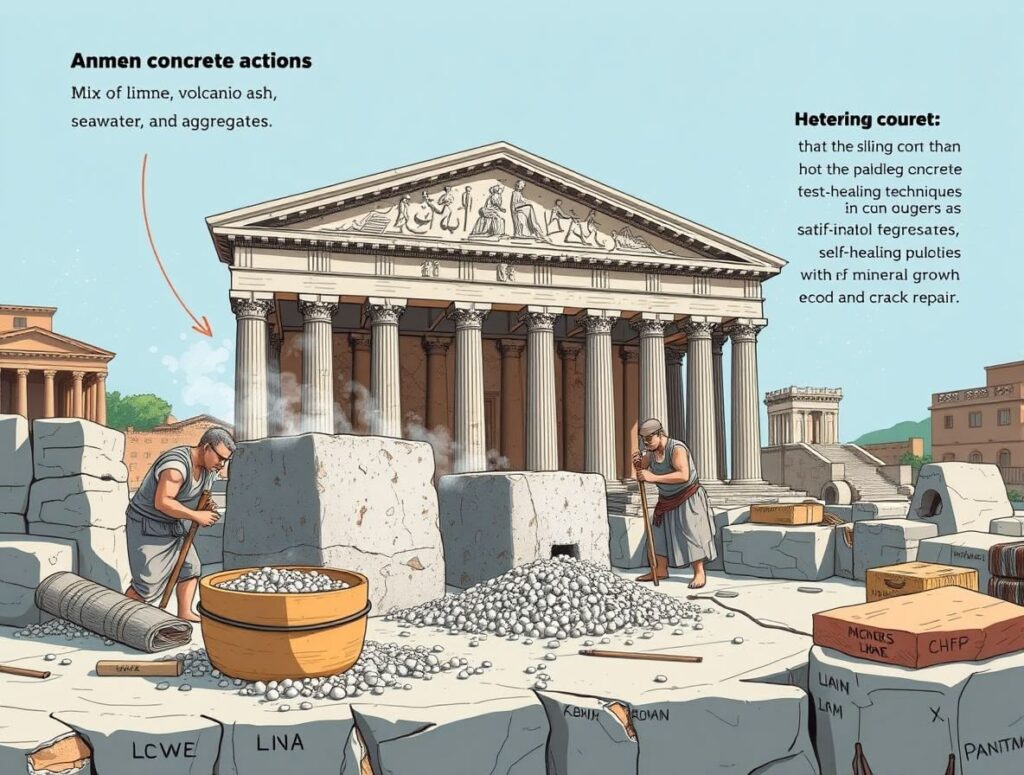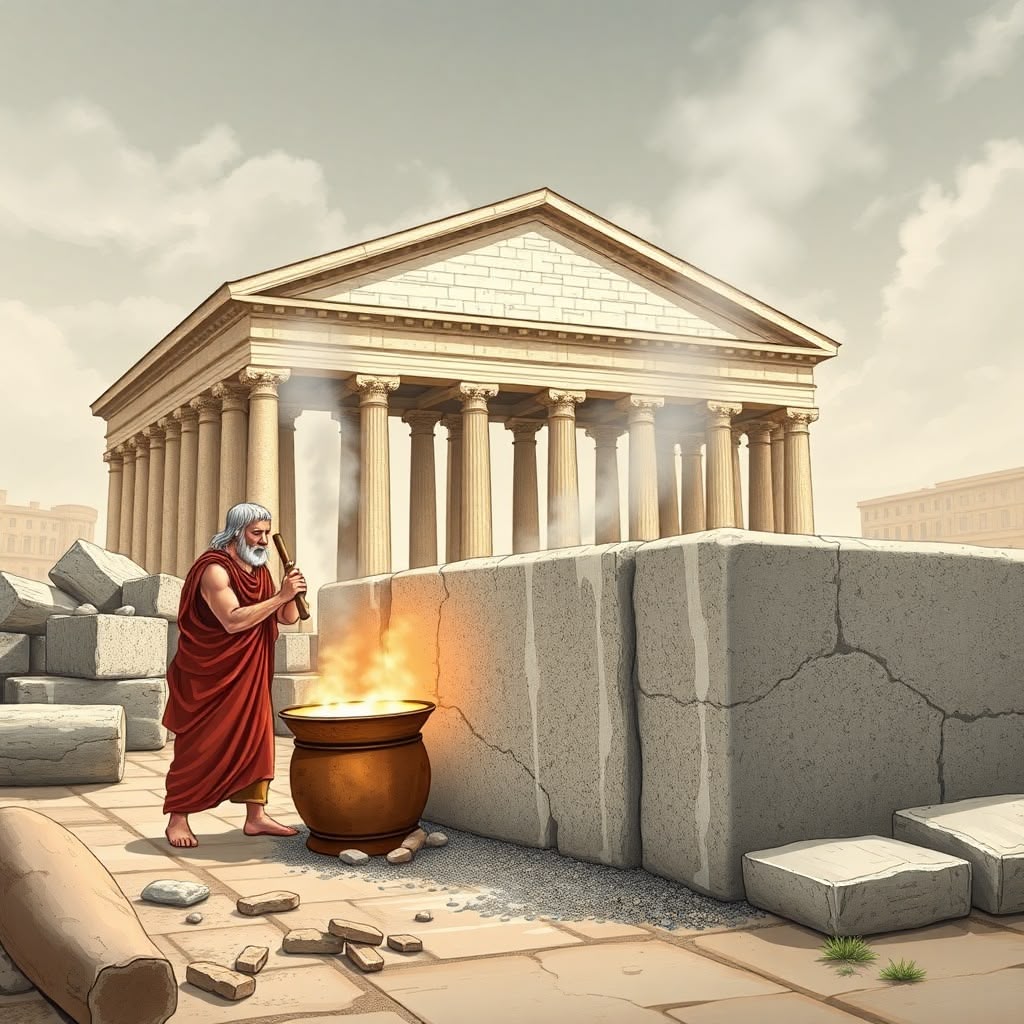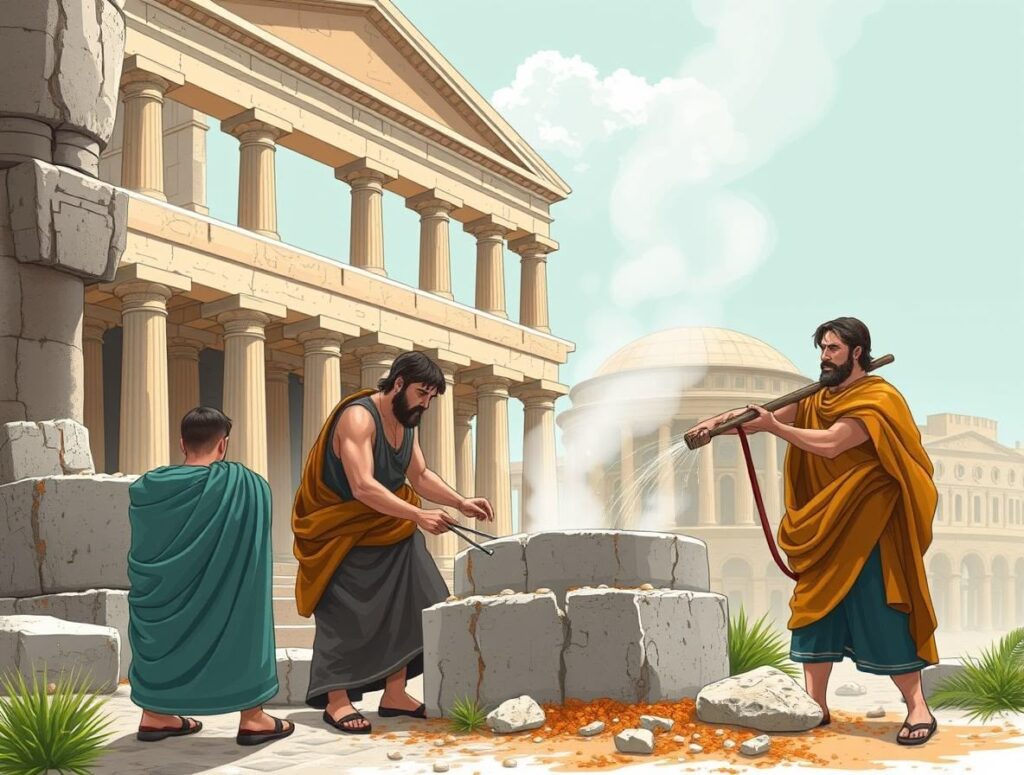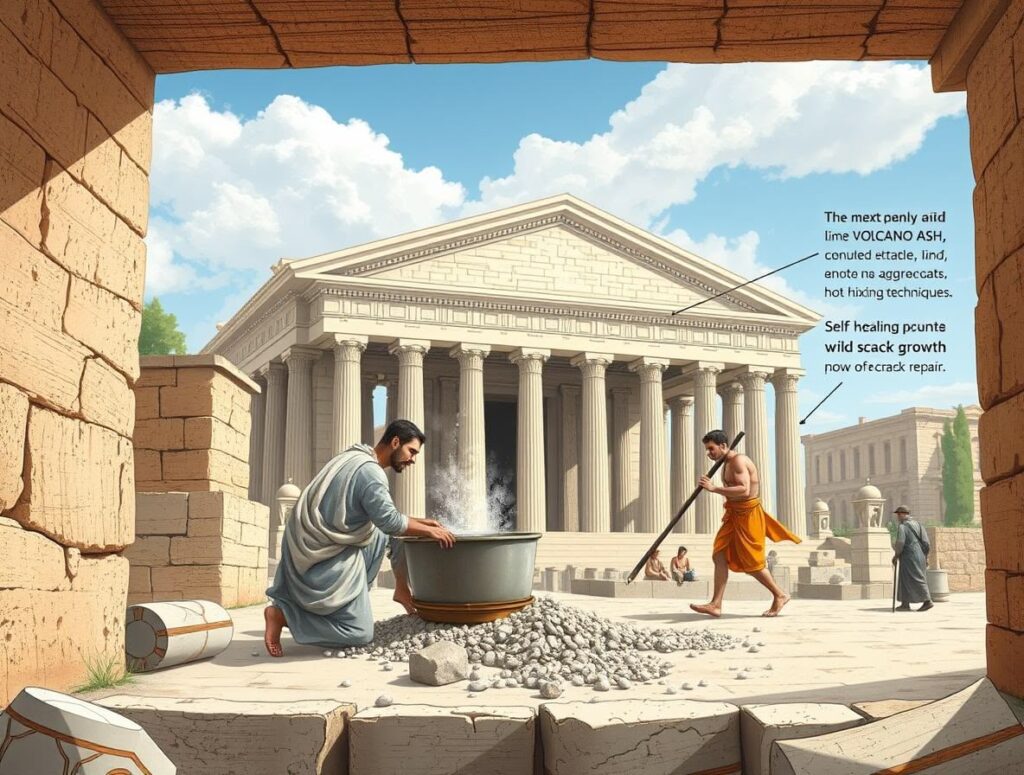The Science of Roman Concrete: Lessons for Sustainable Building in 2025 explores the ancient innovation of Roman concrete and its relevance to contemporary sustainable building practices.
Roman concrete, known as Opus Caementicium, transformed construction with its remarkable strength lasting over centuries without steel reinforcement.
With environmental issues being a top priority, the demand for sustainable building materials and methods is crucial for upcoming construction projects.
Examining Roman concrete provides valuable knowledge on eco-friendly building techniques that can shape sustainable construction practices in 2025 and beyond. This ancient innovation not only offers important lessons for sustainable building but also reflects the wider impact of Roman law, which has influenced modern legal systems, and Roman mythology, which continues to affect present-day culture.
Historical Background of Roman Concrete
Roman concrete, known as Opus Caementicium, transformed ancient construction practices with its remarkable durability and longevity.
Development and Characteristics
Roman concrete was a breakthrough material developed by the ancient Romans, consisting of a mixture of lime, volcanic ash, seawater, and aggregates. This unique composition gave it unparalleled strength and resilience.
Comparison with Modern Concrete
Unlike modern concrete that typically lasts around 150 years and often requires steel reinforcement, Roman concrete structures like the Pantheon have stood for nearly 2,000 years without such support. The secret lies in its chemical composition and self-healing properties.
Examples of Long-lasting Structures
The Pantheon in Rome is a testament to the longevity of Roman concrete. Built over two millennia ago, this iconic structure still stands as a marvel of ancient engineering. Other examples include the Colosseum and aqueducts that have defied time and elements.
Through the use of Opus Caementicium in their architectural marvels, the Romans showcased not only their engineering prowess but also an understanding of materials that surpassed their time. The comparison between Roman concrete and its modern counterpart highlights the enduring legacy of this ancient building material.
The Roman Republic played a crucial role in the development and implementation of such advanced construction techniques. This period marked a significant transition in governance from monarchy to a complex political structure which laid the foundation for modern democracies.
Moreover, during this era, agriculture was a crucial driver of Rome’s economic and social development. This sector extended beyond mere food production, influencing various aspects of Roman life including construction.
Additionally, the Twelve Tables, created between 451-450 BCE, were pivotal in shaping Roman law and legal history. These laws were the first attempt to codify the complex legal practices of ancient Rome.
Lastly, understanding the ancient Roman religion can provide deeper insight into how these factors intertwined with every aspect of their lives including politics, culture, and social structures.

Key Ingredients of Roman Concrete
Roman concrete’s exceptional durability stems from a carefully balanced blend of four primary components: lime, volcanic ash, seawater, and aggregate. Each ingredient played a unique role in creating a material that could withstand centuries of environmental stress, a testament to the ancient concrete’s ability to stand the test of time.
1. Lime (Calcium Oxide)
Lime served as the fundamental binder in Roman concrete. When mixed with water, it forms calcium hydroxide, which reacts chemically with volcanic ash to initiate a slow but strong hardening process. This reaction differs significantly from the rapid setting of modern Portland cement, allowing Roman concrete to gain strength over time.
2. Volcanic Ash from the Bay of Naples
Known as pozzolana, this fine volcanic ash was critical for imparting chemical stability and resilience. Its siliceous and aluminous compounds react with lime in the presence of water to form long-lasting binding minerals. The unique composition of Bay of Naples ash made it especially reactive, enhancing the concrete’s resistance to cracking.
3. Seawater
Contrary to modern practice that avoids saltwater contact due to corrosion risks, Romans intentionally used seawater to mix their concrete destined for marine structures. Seawater contributed essential ions that fostered the growth of rare minerals such as aluminum tobermorite within the matrix—minerals responsible for strengthening and self-healing properties over decades.
4. Aggregates
Small stones, rubble, and ceramic fragments provided bulk and structural integrity. These aggregates acted as a skeleton within which the lime-pozzolana paste could bind firmly. Their rough texture improved mechanical interlock and helped distribute stresses throughout the concrete mass.
Understanding these ingredients reveals why Roman concrete remains an unparalleled example of sustainable ancient technology capable of inspiring modern building materials. The incredible engineering feats associated with Roman architecture, including its roads which served as the backbone of an empire, are testaments to this advanced understanding of materials and construction techniques.
Formation Process of Calcium-Aluminium-Silicate-Hydrate in Roman Concrete
The hallmark of Roman concrete’s durability lies in the mineral growth within its matrix, specifically the formation of calcium-aluminium-silicate-hydrate (C-A-S-H). This mineral forms through a slow chemical reaction between lime (calcium oxide), volcanic ash rich in aluminosilicates, and seawater. When these components interact, they trigger a crystallization process that produces C-A-S-H—a robust binder responsible for strengthening the concrete over time.
This mineral growth is not static. It actively repairs micro-cracks that develop due to environmental stressors like weathering or seismic activity. The mechanism works as follows:
- Water penetrates cracks in the concrete.
- Dissolution of calcium-rich inclusions occurs at the crack interfaces.
- Released calcium ions react with aluminosilicates from volcanic ash.
- New C-A-S-H crystals form and fill the cracks.
This self-healing property reinforces the structure’s integrity without external intervention. Unlike modern concrete, which relies heavily on steel reinforcement and often degrades after decades, Roman concrete’s ability to regenerate its mineral structure contributes directly to its longevity.
Understanding this chemical interplay offers valuable insights into sustainable building practices today. Harnessing similar self-healing mechanisms could reduce maintenance costs and extend service life, aligning with the goals outlined in The Science of Roman Concrete: Lessons for Sustainable Building in 2025.

Hot Mixing Technique in Roman Concrete Production
Roman concrete’s exceptional durability owes much to the hot mixing technique employed during its production. This process began by mixing dry quicklime granules directly with volcanic ash, a key departure from modern methods that usually combine these ingredients with water from the start. Heating the quicklime caused it to react partially with the ash before water was introduced, triggering unique chemical changes.
Key aspects of the hot mixing process:
- Dry blending of quicklime and volcanic ash at elevated temperatures.
- Formation of reactive compounds prior to hydration.
- Addition of water only after this initial reaction stage.
This technique led to the creation of calcium-rich inclusions, tiny mineral aggregates embedded within the concrete matrix. These inclusions serve multiple functions:
- Act as internal reservoirs of calcium, essential for ongoing chemical reactions.
- Facilitate continuous growth of strengthening minerals like calcium-aluminium-silicate-hydrate over time.
- Enable a natural self-healing mechanism by dissolving and redepositing calcium compounds in cracks or damaged areas.
The presence of these calcium-rich inclusions distinguishes Roman concrete from modern mixtures, which lack such self-regenerating features. The hot mixing method thus not only enhanced initial strength but also contributed significantly to the material’s remarkable longevity and resilience under harsh environmental conditions.
The ability to produce such resilient structures was a testament to the skills and knowledge of the patricians, who were masters of Roman luxury and power, often employing advanced techniques like this in their architectural endeavors.
Environmental Impact and Sustainability Considerations of Roman vs. Modern Concrete Production Techniques
1. CO2 Emissions: A Comparison
Roman concrete production had a fundamentally different environmental footprint compared to modern methods. The traditional Roman technique relied heavily on natural volcanic ash and lime, materials that required lower-energy processing than the high-temperature kilns used for Portland cement today. This difference directly affects CO2 emissions.
Modern concrete manufacturing accounts for approximately 8% of global CO2 emissions, largely due to the calcination process in producing Portland cement and the massive scale of industrial operations. By contrast, Roman methods emitted significantly less carbon because:
- Lime was produced at lower temperatures.
- Volcanic ash, a natural pozzolan, reduced the need for energy-intensive components.
- The hot mixing process utilized chemical reactions that enhanced durability without synthetic additives.
2. Durability’s Role in Sustainability
Durability plays a critical role in sustainability. Roman concrete’s ability to self-heal and strengthen over centuries means structures require less frequent repair or replacement. This longevity translates into smaller carbon footprints because fewer resources are consumed over time for maintenance and reconstruction.
3. Lessons from the Romans for Sustainable Construction
Adopting principles from Roman concrete can inspire the development of eco-friendly materials capable of reducing overall emissions in construction. Integrating natural pozzolans and refining mixing processes may lower energy demands and extend the life cycle of modern buildings. Such sustainable building practices present a promising pathway toward mitigating climate impact within the construction sector.
The techniques used by the Romans in their concrete production are not just an architectural marvel, but they also reflect a period marked by significant political transformation, such as the birth of the Roman Republic. Understanding this transition can provide valuable insights into the socio-political context that allowed such innovative construction techniques to flourish.

Challenges and Opportunities for Modern Industry Adoption of Ancient Techniques like Hot Mixing and Self-Healing Properties
The Science of Roman Concrete: Lessons for Sustainable Building in 2025 highlights both significant barriers and promising opportunities when integrating ancient methods into modern construction. The spectacle of ancient Rome provides a fascinating backdrop to understanding the cultural significance of these ancient techniques.
Barriers Faced by the Contemporary Construction Industry
- Cost Concerns: Developing and scaling hot mixing processes require specialized equipment and materials, increasing upfront expenses compared to conventional concrete production. Budget constraints often discourage experimentation with these novel approaches.
- Resistance to Change: The construction sector is traditionally conservative, favoring tried-and-tested techniques. Introducing unfamiliar methods like self-healing concrete demands extensive testing, certification, and retraining, which slows adoption.
- Regulatory Hurdles: Building codes and standards are designed around existing materials. Adapting regulations to accommodate emerging technologies based on Roman concrete principles can be slow and complex.
Opportunities for Enhancing Sustainability through Innovation
- Longevity Reducing Maintenance Costs: Self-healing properties decrease repair frequency over a building’s lifespan, cutting long-term maintenance expenses while reducing resource consumption.
- Lower Carbon Footprint: Incorporating volcanic ash or similar pozzolanic materials reduces reliance on energy-intensive Portland cement, offering a pathway to reduce CO2 emissions.
- Material Efficiency: Hot mixing creates calcium-rich inclusions that enhance durability without heavy reinforcement, potentially lowering steel use—a major contributor to construction emissions.
- Cross-disciplinary Innovation: Collaboration between chemists, material scientists, and engineers can accelerate adaptation of these ancient techniques using modern technology for scalable applications.
Understanding these challenges alongside opportunities allows the industry to begin bridging ancient wisdom with contemporary sustainability goals. This integration is not just about adopting new methods; it’s also about embracing the rich history and culture of ancient Rome, which is filled with remarkable stories and lessons that can inspire modern practices. From the daily life in ancient Rome to its architectural marvels, there’s much we can learn from this fascinating period in history.
Research Efforts in Recreating Ancient Techniques: A Case Study on MIT Chemist Admir Masic’s Work
MIT chemist Admir Masic is leading the way in research efforts to revive ancient Roman concrete techniques for modern sustainable construction practices. His work combines historical knowledge, such as the legacy of ancient Rome, with cutting-edge scientific advancements to create eco-friendly building materials that have the potential to transform the construction industry.
Understanding Roman Concrete
Masic’s primary focus is on understanding the complex chemistry behind Roman concrete and finding ways to apply it to current problems. By connecting ancient methods with present-day needs, he aims to create materials that are not only strong and long-lasting but also environmentally friendly.
Inspiration from Everyday Life
Through his detailed research and experiments, Masic reveals how ancient techniques, like those used by plebeians in their daily lives, can inform sustainable construction practices in 2025 and beyond. His work serves as a source of inspiration for researchers and industry professionals seeking to implement greener approaches based on the knowledge of the past.
Reviving Art and Culture
This project not only highlights the significance of art and culture in ancient Rome but also demonstrates how these age-old practices can be adapted to fulfill contemporary sustainability objectives.

Conclusion
Science of Roman Concrete: Lessons for Sustainable Building in 2025 offers valuable insights that could redefine sustainable construction. Implementing ancient techniques like using volcanic ash, hot mixing, and self-repairing minerals can lead to:
- Longer-lasting concrete structures, reducing the need for frequent repairs and rebuilds.
- Reduced carbon emissions by minimizing cement production and adopting energy-efficient practices.
- Improved durability that naturally adapts to environmental challenges, enhancing safety and resilience.
The future of sustainable construction in 2025 relies on combining historical knowledge with modern technology. Innovations inspired by Roman concrete have the potential to turn building materials into eco-friendly solutions designed for today’s environmental issues. This blend of past and present wisdom promotes a transition from temporary infrastructure to long-term sustainability, establishing new benchmarks for durability, efficiency, and environmental responsibility in the construction industry.

